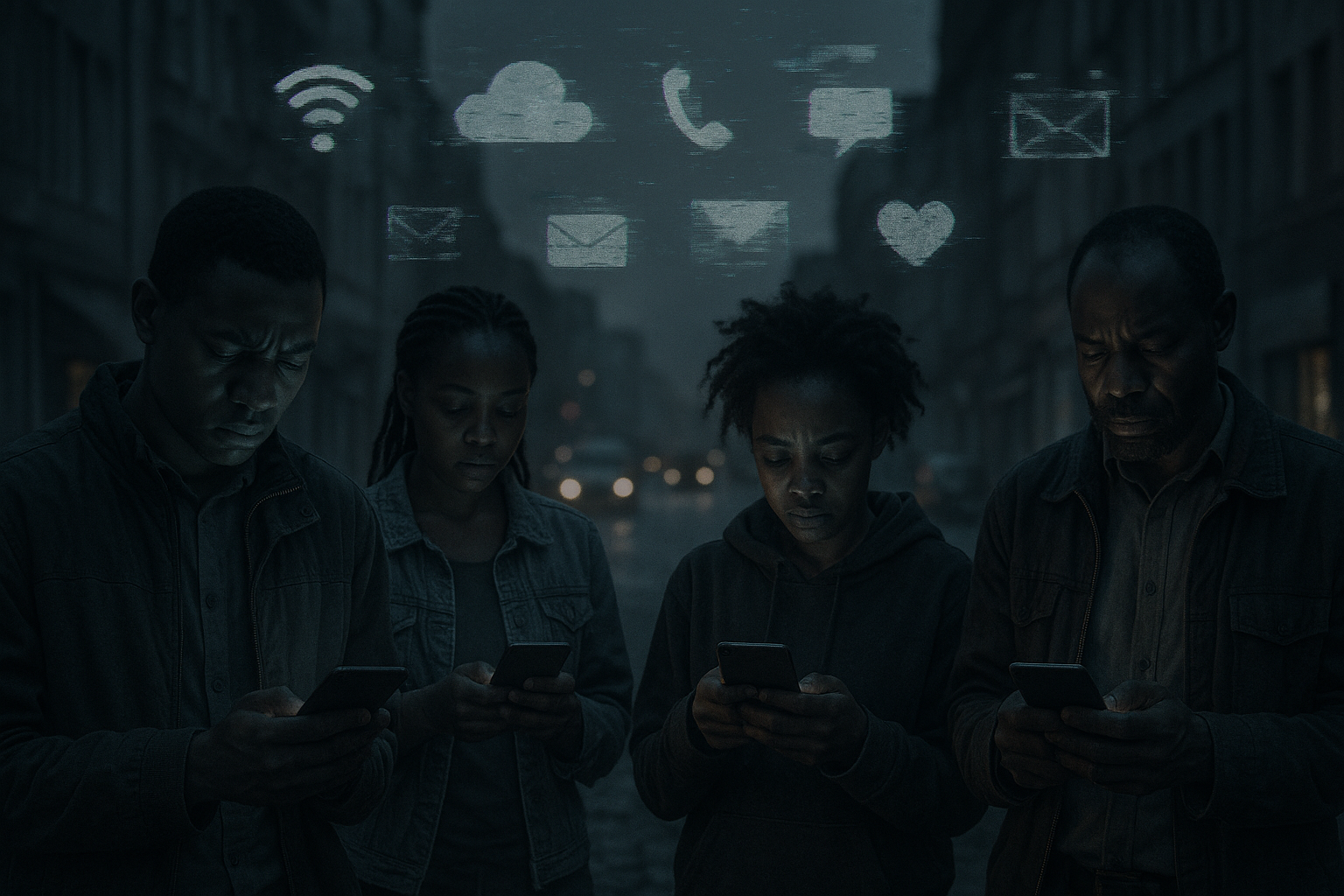Introduction: When the Digital World Went Dark
In 2025, the digital landscape experienced a series of unprecedented disruptions that sent shockwaves through the business community. From Meta’s platforms going dark to X experiencing multiple consecutive failures, these social media outages revealed a fundamental truth that many entrepreneurs and business owners had been reluctant to acknowledge: our digital dependence has reached critical levels, and the consequences of this reliance extend far beyond mere inconvenience.
For small businesses, startups, and entrepreneurs who have built their entire customer acquisition and engagement strategies around social media platforms, these outages weren’t just technical glitches—they were existential threats. This comprehensive analysis explores what happened during the social media outages of 2025, the lessons learned, and the actionable strategies your business needs to implement today to protect against similar disruptions tomorrow.
The Great Social Media Blackout: A Timeline of 2025’s Major Outages
March 2025: The Meta Meltdown
The year began with a significant disruption when Facebook and Instagram experienced a major outage that left millions of users worldwide struggling to access the platforms. This wasn’t an isolated incident—Meta’s services including Facebook, Instagram, Messenger, and Threads were all affected, with users either unable to load new posts or completely logged out of their accounts.
The timing couldn’t have been more critical. The outage occurred during a crucial business period when companies were launching spring campaigns and connecting with customers. The disruption sparked widespread concerns about the impact on businesses and individuals who rely on Instagram for marketing, sales, and communication.
X Platform: A Year of Recurring Failures
Elon Musk’s social media platform X (formerly Twitter) experienced perhaps the most turbulent year of any major platform. In March 2025, X went down multiple times in a single day, with over 21,000 incidents reported in the U.S. and 10,800 in the U.K., with the platform experiencing roughly 45-minute outages that repeated throughout the day.
The problems didn’t stop there. In May 2025, approximately 25,000 users reported issues with X, experiencing intermittent problems until about 11 a.m. ET. These recurring failures prompted even Musk himself to acknowledge that major operational improvements needed to be made.
The Cascade Effect: August and Beyond
As summer approached, the outages continued. In August 2025, X experienced another brief outage, with initial reports suggesting a much larger problem, though service returned within an hour. The same month, Facebook users across multiple regions faced significant access problems, with Downdetector recording a dramatic surge with over 330 users reporting issues at peak times.
Understanding the True Cost: The Business Impact of Social Media Outages
Financial Losses and Revenue Disruption
The financial implications of social media outages extend far beyond what most business owners initially realize. Historical data from major outages provides sobering context: during the October 2021 Facebook outage, which lasted approximately six hours, the company lost over $100 million, with $40 billion wiped off Facebook’s market cap, while also disrupting small businesses, e-commerce, and even emergency communications in some regions.
Small businesses that depend heavily on Instagram and Facebook for advertising and selling their products face significant challenges, as they are often forced to shut down temporarily during outages, resulting in direct revenue loss. For many entrepreneurs, social media platforms aren’t supplementary marketing channels—they’re the primary, and sometimes only, storefront.
The Ripple Effect on Business Operations
The impact of social media outages extends far beyond direct sales losses. The disruption affected business users who rely on Facebook for professional communications and marketing activities, with particular concerns about Facebook business pages.
Consider the interconnected nature of modern digital business: users reported being unable to access other platforms that rely on Facebook for authentication, with gaming platforms and fitness tracking applications like Strava all experiencing related problems. This cascade effect means that a single platform’s failure can disrupt multiple services simultaneously, creating a domino effect across your entire digital ecosystem.
The Customer Trust Equation
Beyond immediate financial impact, social media outages damage something far more valuable: customer trust and brand reputation. 73% of social media users agree that if a brand doesn’t respond on social media, they’ll buy from a competitor. When your primary communication channel goes dark during a critical customer service moment, you’re not just losing one transaction—you’re potentially losing that customer forever.
Nearly three-quarters of consumers expect a response on social media within 24 hours, while 76% of consumers value how quickly a brand can respond to their needs. When social media platforms fail, these expectations don’t disappear—they simply can’t be met, leaving customers frustrated and businesses helpless.
The Vulnerability of Digital Dependence: What We Learned
Single Points of Failure
The widespread nature of Meta’s outages suggests problems occurred in a part of Meta’s systems that wasn’t replicated, indicating a single point of failure—something relied upon by all services without which none can function. This architectural vulnerability reveals a critical lesson: the platforms we depend on aren’t as robust as we might assume.
For businesses, this translates into a stark reality check. If Meta, with its billions in resources and engineering talent, can experience catastrophic failures, what makes us think our business operations—entirely dependent on these platforms—are secure?
The Illusion of Platform Reliability
The frequency and unpredictability of 2025’s social media outages shattered the illusion of platform reliability. X has experienced several large-scale outages since Musk’s takeover, with users reporting problems in December 2022 and July 2023. These aren’t rare “black swan” events—they’re becoming an expected part of the digital landscape.
Social media outages are rare events, but they happen, and even though outages may last only a few hours, they clearly indicate people’s dependency on social media platforms. The question isn’t if another major outage will occur, but when—and whether your business will survive it.
The Cost of Putting All Eggs in One Basket
One crucial lesson that social media outages provide is that it is essential for individuals, especially businesses, to diversify their presence on other platforms, as keeping all the eggs in one platform can be a huge mistake. Yet despite this obvious wisdom, many businesses continue to concentrate their entire digital presence on one or two social media platforms.
Why? Because building presence across multiple platforms requires time, resources, and strategic planning—investments that startups and small businesses often feel they can’t afford. The 2025 outages proved that not making these investments is far more expensive.
Building Digital Resilience: Strategic Responses for Modern Businesses
Understanding Business Continuity vs. Business Resilience
To protect your business from social media outages, you must first understand the difference between business continuity and business resilience. Business continuity is how an organization carries out mission-critical business functions during disruption and emergencies, while business resilience is the ability of an organization to adapt to changes to promote long-term growth.
Business continuity ensures uninterrupted operations by implementing plans, policies, and procedures, particularly in the face of disruptions, acting as a proactive strategy to maintain core functions and preserve reputation, customer trust, and overall business viability. In the context of social media dependence, this means having backup systems and alternative communication channels ready before disaster strikes.
The Three Pillars of Digital Resilience
1. Risk Management and Assessment
Risk management starts with identifying potential risks and vulnerabilities through thorough assessments, enabling businesses to proactively mitigate risks and allocate resources efficiently to safeguard critical assets. For social media-dependent businesses, this means:
- Conducting regular audits of your digital infrastructure
- Identifying which business functions are entirely dependent on social media
- Calculating the financial impact of a 24-hour social media outage
- Mapping out alternative communication channels and their current capabilities
2. Adaptability and Flexibility
In a dynamic business landscape, being open to innovation and change is vital, as adaptability and flexibility allow businesses to swiftly adjust strategies and operations in response to challenges and opportunities. The companies that thrived during 2025’s social media outages were those that could quickly pivot to alternative channels without missing a beat.
3. Comprehensive Continuity Planning
Developing comprehensive plans ensures the continuity of essential functions during disruptions, minimizing downtime and protecting reputation, with recovery plans and predefined responses to scenarios like natural disasters or cyberattacks being critical.
Practical Strategies: Diversifying Your Digital Presence
Building a Multi-Channel Communication Strategy
The most critical lesson from 2025’s social media outages is simple: never depend on a single communication channel. Here’s how to build a robust multi-channel strategy:
Email Marketing: Your Owned Asset
Unlike social media followers, your email list is an asset you truly own. No platform can take it away, and no outage can prevent you from reaching your subscribers. Email won’t have outages and policy changes like social media platforms, making it an essential foundation for business resilience.
Invest in building and nurturing your email list by:
- Offering valuable lead magnets that incentivize sign-ups
- Creating regular, valuable content that keeps subscribers engaged
- Segmenting your list for personalized communications
- Implementing automated email sequences for consistent engagement
Website and Blog: Your Digital Headquarters
Your website is the only digital property you truly control. While social media platforms can change algorithms, implement new policies, or experience outages, your website remains your constant. Develop it as your business’s digital headquarters by:
- Creating valuable, SEO-optimized content that drives organic traffic
- Implementing robust customer service features like chatbots
- Building community features like forums or comment sections
- Ensuring mobile optimization and fast loading speeds
SMS and WhatsApp Business
Direct messaging channels offer personal, immediate communication that doesn’t rely on social media platform stability. These channels experienced significant growth during 2025’s outages as businesses scrambled for alternatives.
Alternative Social Media Platforms
Don’t abandon social media entirely—just don’t depend on it exclusively. Maintain presence across multiple platforms:
- LinkedIn for B2B and professional networking
- TikTok for younger demographic engagement
- Pinterest for visual product discovery
- Emerging platforms that your target audience adopts
Creating Your Business Continuity Plan
A business continuity plan is a document that identifies the most essential business functions and how they should be maintained during a crisis. For social media-dependent businesses, this plan should include:
Crisis Communication Protocols
A crisis management plan outlines the steps and considerations an organization needs to strategically respond to a disruption. When social media goes down, your team should know exactly:
- Which alternative channels to activate immediately
- Who is responsible for executing each part of the response
- Pre-drafted communications to send via email and other channels
- How to redirect customer service inquiries to available channels
Emergency Response Procedures
An emergency response plan details procedures that should be followed to mitigate various types of threats and ensure preservation of life. While social media outages aren’t life-threatening, they can be business-threatening. Your plan should detail:
- How to maintain customer service during outages
- Procedures for fulfilling orders when social commerce fails
- Methods for continuing marketing campaigns through alternative channels
- Communication protocols for internal team coordination
Technology Disaster Recovery
An IT disaster recovery plan describes procedures for the recovery of critical IT systems, data and other technology assets. Ensure your business can:
- Access customer databases and contact information from multiple locations
- Continue processing orders through alternative systems
- Maintain access to critical business applications and data
- Switch between communication platforms seamlessly
Testing and Refinement
By regularly testing and updating the business continuity plan, organizations can ensure they are prepared for various disruptive scenarios while fostering a culture of resilience and readiness. Don’t wait for the next major outage to discover gaps in your planning.
Conduct quarterly “outage drills” where you:
- Simulate a 24-hour social media blackout
- Test your team’s ability to execute the continuity plan
- Measure customer response times through alternative channels
- Identify and address weaknesses in your backup systems
The Future of Digital Business: Embracing Resilience
The Growing Regulatory Landscape
The recurring nature of social media outages hasn’t gone unnoticed by regulators. Countries around the world are beginning to create legislation and regulatory standards to require operational resilience, beginning with critical sectors like financial services, with the European Union’s proposed Digital Operational Resilience Act (DORA) seeking to ensure that all financial market participants have effective strategies and capabilities in place.
While social media platforms themselves may face increased regulatory scrutiny, businesses that depend on these platforms must take their own resilience seriously. The burden of business continuity ultimately rests with individual companies, not the platforms they use.
Investing in Digital Transformation
In 2025, businesses need to embrace digital transformation to stay resilient in the face of disruption, as moving to a digital-first approach allows companies to improve response times, reduce human error, and ensure compliance with regulatory standards.
This doesn’t mean abandoning social media—it means building a more sophisticated, resilient digital infrastructure that includes social media as one component rather than the entire foundation.
Digital transformation has brought numerous benefits for businesses globally, from improved efficiency and customer experience to innovative products and services, but this shift also introduces new risks that can disrupt business operations and result in significant losses if not properly managed.
Building a Resilience-First Culture
In the wake of the pandemic, multiple supply chain disruptions, and an uncertain economic climate, 84% of organizations have discussed the value of organizational resilience, and 70% plan to invest even more in building resilience.
The businesses that will thrive in an increasingly unstable digital landscape are those that:
- Treat resilience as a strategic priority, not an IT problem
- Invest proactively in backup systems and alternative channels
- Regularly test and update their continuity plans
- Foster organizational cultures that value adaptability and preparedness
Lessons for Startups and Small Businesses
Starting with Resilience in Mind
For startups and new businesses, the lesson from 2025’s social media outages is clear: build resilience into your business model from day one. While it’s tempting to leverage free social media platforms as your primary (or only) marketing channel, this short-term cost savings creates long-term vulnerability.
Instead, consider resilience as a competitive advantage. While your competitors scramble during the next major outage, your business continues operating smoothly because you’ve built redundancy and flexibility into your digital infrastructure.
The ROI of Resilience
Business continuity efforts act as a safety net, facilitating swift recovery to prevent prolonged downtime and mitigate financial loss. When you calculate the true cost of social media dependence—including potential revenue loss during outages, damage to customer relationships, and competitive disadvantages—investing in resilience becomes an obvious choice.
Consider this: if your business generates $10,000 daily through social media channels, a single 24-hour outage costs you that amount. If outages occur even quarterly (which 2025 proved is not unrealistic), that’s $40,000 annually. How much could you invest in building resilient backup systems for less than that cost?
Resource-Conscious Resilience Building
For resource-constrained startups and small businesses, building resilience doesn’t require massive investments. Start with these high-impact, low-cost actions:
- Begin building an email list immediately – Every social media follower should be invited to join your email list through compelling offers and content.
- Establish a basic website – Modern website builders make it affordable and simple to create a professional online presence that you control.
- Document your processes – Create simple, written procedures for what your team should do during a social media outage.
- Diversify gradually – You don’t need to master every platform simultaneously. Add one new channel per quarter, building competence before expanding further.
- Leverage automation – Use tools that allow you to schedule posts across multiple platforms, maintain email campaigns, and automate customer service responses.
Taking Action: Your 90-Day Resilience Implementation Plan
Month 1: Assessment and Planning
Week 1-2: Conduct Risk Assessment
- Calculate your current social media dependence (% of revenue, customer acquisition, customer service)
- Identify critical vulnerabilities in your current digital infrastructure
- Survey your customers about their communication channel preferences
- Analyze competitors’ multi-channel strategies
Week 3-4: Develop Your Continuity Plan
- Define essential business functions and their backup channels
- Assign team responsibilities for executing the plan
- Create emergency communication templates for various channels
- Establish metrics for measuring resilience effectiveness
Month 2: Infrastructure Development
Week 5-6: Build Alternative Channels
- Launch or enhance your email marketing program
- Optimize your website for conversions and customer service
- Set up SMS/messaging capabilities for direct customer communication
- Establish presence on at least one alternative social platform
Week 7-8: Integration and Automation
- Implement tools that enable cross-platform communication
- Set up automated backup systems for customer data
- Create content libraries accessible across all channels
- Develop customer service workflows for multiple platforms
Month 3: Testing and Refinement
Week 9-10: Conduct Resilience Testing
- Run a simulated social media outage drill
- Test customer communication through alternative channels
- Measure team response times and effectiveness
- Identify gaps and weaknesses in your systems
Week 11-12: Optimize and Document
- Refine your continuity plan based on testing results
- Train team members on updated procedures
- Create easily accessible documentation for all processes
- Schedule regular review and update cycles
Conclusion: Turning Vulnerability into Strength
The social media outages of 2025 delivered a painful but valuable lesson about our digital dependence. For businesses that relied exclusively on social media platforms for customer acquisition, engagement, and service, these outages represented existential threats. But within this challenge lies tremendous opportunity.
By understanding the true cost of digital dependence and taking proactive steps to build resilient, multi-channel business operations, you transform vulnerability into competitive advantage. While others scramble during the next inevitable outage, your business continues operating smoothly, maintaining customer relationships and capturing market share.
76% of all users say social media has influenced their purchases over the past six months, and 56% of marketing leaders say social media drives revenue. Social media remains powerful and valuable—but it must be one component of a diversified digital strategy, not the entire foundation.
The question facing every business owner, entrepreneur, and startup founder is simple: Will you wait for the next major social media outage to expose your vulnerabilities, or will you act now to build the resilience your business needs to thrive in an increasingly unstable digital landscape?
The businesses that succeed in the coming years won’t be those with the largest social media followings—they’ll be those with the most resilient, diversified, and adaptable digital ecosystems. The time to build that resilience is now, while your social media channels are still functioning and you have the luxury of planning rather than panic.
Additional Resources
For more information on building business resilience and digital continuity:
- International Organization for Standardization (ISO) Business Continuity Standards
- U.S. Cybersecurity and Infrastructure Security Agency Resources
- Business Continuity Institute Best Practices
- DownDetector – Real-time Outage Monitoring




